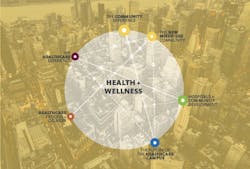Like healthcare, design is about the individuals who collectively make up the whole. One powerful thread carrying through this blog series has been the importance of the human experience; that healthcare providers need to connect with their communities at all scales and build improved experiences.
On June 13, nearly 100 of our clients and colleagues gathered for “The Patient Will See You Now: Your Healthcare Future” event at Gensler’s Washington, DC, office. To offer a glimpse into the future of healthcare, we brought together six leaders in the field, quoted below, for a robust discussion drawing on their distinct perspectives—from telemedicine and algorithmic medicine to genomics and community health.
Out of the many insights that night, everyone agreed that the healthcare industry is ripe for disruption and that communities contribute immensely to our health and wellness. The paneslists spoke to the ways in which design is shaping the future of healthcare by connecting communities at three levels.
Panelists discussing the future of healthcare at Gensler's DC office. Image © Gensler.
Creating The Space For Self Care
“We can, and should, be the leaders in own wellbeing,” says Dr. Mark Rowe. “We have a certain indispensability as human beings to prioritize ourselves, as well as others.” One in two healthcare providers suffer from symptoms of burnout, a national epidemic putting doctors and patients at risk. Human-centered design begins at the personal level; it is design for all humans. Good healthcare design should focus on patients, but design should also consider others in the space—the physician and nurses, the patient’s family, the healthcare accountant and systems engineer.
Nick Dawson, Executive Director of the Johns Hopkins Sibley Innovation Hub, spoke in detail of their successful “tranquility room”—a space for caregivers to recharge. While doing research on noise and acoustics to improve the patient experience at the hospital, Nick’s colleagues found that most stressful noise was the sound of someone in pain—a sound that caregivers hear every day. The research team realized that before they could help the patients, they needed the help the staff, and the idea for the “tranquility room” developed. After spending a few moments in this room, with ambient music and a cup of tea, nursing staff commented—at times through tears—that it was the “best break they ever had.”
Healthcare settings are not alone in needing to combat burnout and workplace stress; financial trading also ranks among the most high-pressure and stressful knowledge worker occupations. Gensler’s research identifies opportunities for design to improve the health and well-being of traders, as well as healthcare providers, through ergonomic, technological and design strategies to design healthier environments.
Healthcare Is a Team Sport
“Healthcare teams of the future are about collaboration.” Mike Baird, the CEO of telemedicine firm Avizia, believes they can build a better doctor’s visit through telemedicine. One might think telemedicine eliminates the need for physical space, but that is not necessarily the case. Telemedicine often takes places within a clinic or a hospital, connecting patients to specialists all over the globe. The real key to telemedicine’s success is the ability to create a collaborative workspace. In addition to enabling easy communication between doctors and patients, spaces that enable telemedicine must also serve as comfortable, healthy and productive workplaces for all staff, particularly those who spend significant time on the phone with patients. Team spaces that intermingle the hierarchy of healthcare givers is not the norm, but that trend is changing.
Our research suggests that companies with collaborative workplace design and a culture that values collaboration are more innovative. The key here is value. As the vice president for International Relations for Medtronic, Trevor Gunn spoke about the driving need for value in healthcare, reminding us that the pursuit of human dignity—trying to make sure that you are healthy and your family is healthy—is universal. The best solutions to today’s healthcare issues may come from anywhere in the world. Greater collaboration can help drive these solutions and create more value—i.e. outcomes—in healthcare.
Health Takes a Community
Design can support health by creating access points to health and care across our communities. Blue zones are areas with expanded longevity—like that of the Rosetans, a healthy outlier community described in the first blog of this series. The Inova Center for Personalized Health seeks to drive the genomic revolution, helping people to live longer, healthier lives. Franziska Moeckel, Assistant Vice President at Inova, stressed that the future is not looking solely to physician integration, but looking at the consumer—what do these innovations mean to communities of people and how can they be better integrated?
The conversation around social determinants of health is critically important. Michael Crawford, Chief of Staff for Unity Health Care, routinely asks, “How do we leverage the built environment to increase health?” To do this, doctors at Unity consider the entire community when treating a patient, prescribing ParkRx, an app for a park prescription for exercise or food from farmers’ markets to augment treatments. As master planners and designers, we are equipped to improve the health of communities by considering all aspects of an environment in our design—creating additional healthcare access points.
In the end, we are striving for progress, not perfection. At Gensler, we continually seek to integrate the digital/virtual/physical/emotional experience to enable better health. Stay tuned for our next blog series launching this fall.
About the Author
Gensler
A global design firm with more than 5,000 practitioners networked across five continents, Gensler features insights and opinions of architects and designers on how design innovation makes cities more livable, work smarter, and leisure more engaging. Our contributors write about projects of every scale, from refreshing a retailer’s brand to planning a new urban district, all the while explaining how great design can optimize business performance and human potential. For more thought leadership and blog content, visit our Research & Insight page. Follow us on Facebook, LinkedIn, and Twitter.
